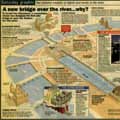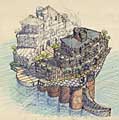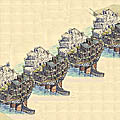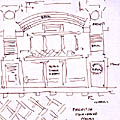![]()
![]()
![]()
![]()
![]()
![]()
![]()
![]()
![]()
![]()
![]()
![]()
![]()
![]()
Scheme for an Inhabited Bridge over the Thames at St.Pauls Steps, 1995 - 1996
- JOA were one of six practices invited to submit a scheme in an ideas competition organised by The Peabody Trust. The entry proved very popular, was featured in two National Dailies, National radio and the Evening Standard and was christened "The Hanging Gardens of Babylon". The schemes were put on public exhibition at the Business Design Centre and the Institute of Civil Engineers.
We saw the Thames as having been largely changed from a very general function for London to a narrower one. Bereft of its previous physical functions of fishpond, water-traffic-route and open sewer, the river is now more of an icon, a symbol, and a spiritual or psychological solace. 20C architecture, being obsessively material in its philosophy, is notably incompetent at 'rationally ordering' anything like a major public symbol.
So we have begun by showing our first "Iconic Engineering" sketches towards this end. We did the Competition more out of regard for Dickon Robinson's enthusiasm for housing as a key part of urbane planning (see our "FAQ#7") rather than any great belief in the idea. However, having invented the design, the newspapers picked it up. We waited to see if there would be serious interest in the idea. But it did not materialise. We had more interesting things to do, back in 1995, than bash away at all those who believe, as many do in Britain (and with good reason) that the best development is the "invisible" development.
This leads, as everyone knows, to the peculiar cult of glass and, so-called' High-Tech and Minimalist thin-ness. The final bridge is called, by its Architect, very typically, a 'blade of light'. The London Eye, also, is almost engineered out of sight. But not, as yet, out of mind.
It seems to me like a memorial to all of our 20C fantasies about glass and steel monorail cities. One rises up it feeling good, climbing into the sky, the light,and so on. Then one gazes out upon the huge mass of tightly-packed real-estate and narrow wandering streets that is the reality of London, chaos capital of commerce, before sinking back into the certainty that monorails will never whizz down the wide, tree-lined, boulevards of this 'city-scape'. And then it starts again on its 'monorail to nowhere' journey. Perhaps that is what fun is all about....dreams that go nowhere.....going up and coming down to where you knew where you were to start with. And where was that, exactly?
Anyway, this "invisible Architecture" is clearly (excuse the pun) what our current Arts Establishment feels most easy with. In fact it betrays an enormous unease with the problem of creating 'public symbols' (we may as well be honest and call such things 'monuments'). Mainly because, I might propose, there is no technique at all, in current Architectural practice outside of Disney and Vegas, for approaching such High-Culture (that is verbal and literary) projects in a properly rational manner. The 'old' High Culture of the Text, whatever its protestations to the contrary, has never believed that the job of a 'public statement', in the 20C milieu of 'mass culture", will lead to anything other than Kitsch. But, as we all know, 'practice makes perfect', and who is really trying?
The other way of 'making this point', which the Establishment is gingernly exploring, is to build something that is clearly offensive, like the new V&A extension. If it is not to be invisible, and if it is not to be Kitsch, then what is left except a patent violation of propriety?
And how will we, in turn, 'violate' that?
What is so peculiar, in all this,
is the unanimous belief that the Architectural, and
especially the Urban, 'Heritage' is both indecipherable and
unsurpassable. This fog of ignorance, and its accompanying
pusillanimity, effectively renders any serious Architecture
impossible. Yet these are two valuations that must both be
wrong. For why should they not be? Are human beings so
terminally stupid and uninventive?
Credits
Clients: Peabody Housing trust
Architects: John Outram Associates
Structural Engineers: Whitby & Bird
* JOA can be reached by E-Mail at anthony@johnoutram.com , by telephone on +44 (0)207 262 4862 or by fax on +44 (0)207 706 3804. We also have an ISDN number : +44 (0)207 262 6294.





